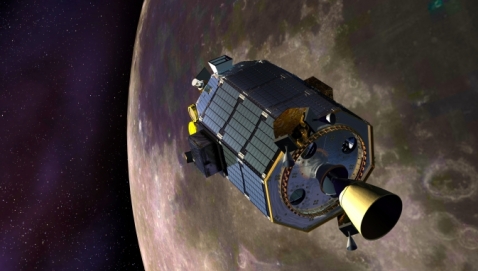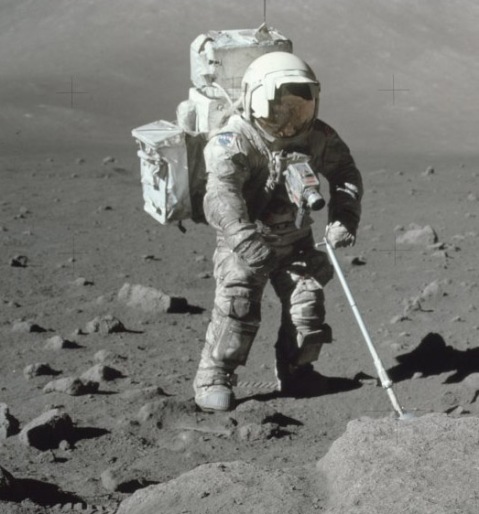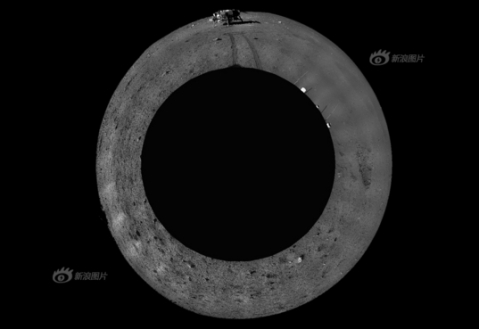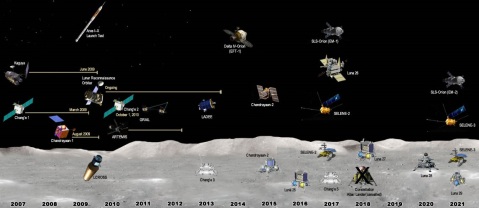Lunar Launches of 2013
2013 was a fantastic year for Moon missions, providing a new orbiter, lander and even a rover to take a fresh look at the lunar surface and what lies below. These instruments are exploring both previously studied and completely new areas of lunar science, including a detailed in situ analysis of the chemical composition of the regolith, the characteristics and origin of the elusive lunar atmosphere, and even some experiments targeting the Earth! The next few years are also set to be some exciting ones with plenty of upcoming missions from around the world. The following is a brief overview of what the brand new lunar companions are up to, what is coming up in the near future, and how all of this could enhance our current understanding of the Earth’s natural satellite.
As you’ve probably heard, China recently launched their Chang’e 3 mission in December 2013, which safely landed on the Moon and immediately deployed its Jade Rabbit rover to begin exploring the surface. Just a few of months prior to this, in September, NASA sent its Lunar Atmosphere and Dust Environment Explorer (LADEE) mission, which is currently in orbit collecting data. These two missions joined three other operational lunar satellites: ex-Earth satellites ARTEMIS P1 + P2, and the Lunar Reconnaissance Orbiter (LRO) which supplies Moon Zoo with all its high resolution images.
LADEE represents the fifth NASA mission to the Moon since 2009 and is after some interesting new data regarding the tenuous lunar atmosphere. The role of dust transport through the Moon’s exosphere is still very poorly understood, so this satellite is designed to study the process in detail as well as analyse general atmospheric properties. The payload contains a UV and visible spectrometer to study the composition of dust grains, a neutral mass spectrometer to search for noble gases present, and a lunar dust experiment to measure grain impacts at different altitudes. Interestingly, the module also carries a laser communication experiment, which is investigating the viability of using lasers to beam back data to Earth. This technology could be incredibly valuable for future missions farther into space as high volumes of data can be transmitted more efficiently than using radio waves.

Artist impression of NASA’s LADEE spacecraft orbiting the Moon.
NASA/ Ames Research Centre/ Dana Berry
So far the mission has already detected atmospheric helium, sodium, neon, potassium and argon-40, as well as confirming a lunar dust exosphere which before was only predicted. The instrument, orbiting between 20 and 150 km, has detected very few dust grains at high altitudes, but this value significantly increased as it descended. LADEE has also measured a few bursts of dust, which are thought to be a consequence of flying through ejecta caused from the impacts of nearby meteorites into the lunar regolith.
Just a few months into LADEE’s mission, the Chinese landed their first craft on another planetary body. The touchdown of Chang’e 3 came more than 40 years after the US sent the first astronauts to walk upon the lunar surface; nonetheless, this does not diminish the mission’s significance at all. The craft, testing out some really exciting new technology and equipment, will be transferring its findings to manned or unmanned missions in the future, heading for the Moon, Mercury or Mars!
The primary mission objective of Chang’e 3 is to analyse the lunar soil composition in situ in much more detail than previously achieved. Its rover, Yutu, or ‘Jade Rabbit’ in English, thus aims to further our understanding of the Moon’s – and in turn the Earth’s – history. At just 1.5 m across, Jade Rabbit carries ground-penetrating radar, cameras, a telescope and spectroscopic instruments to help achieve this goal.
Chang’e 3’s landing destination on the north edge of Mare Imbrium is a different site to those previously visited by the US and USSR missions, with emphasis on how the surface and sub-surface vary from one location to another. Over the course of the mission, it is likely that Moon Zoo will also begin a survey of this area using LRO data, so that participants can help build up a more comprehensive understanding of the site.
Alongside analysing the concentration of elements such as titanium, aluminium, iron, potassium and sodium in the surface materials, there will also be a focus on non-geology related science experiments. On the static landing module one investigation will use an extreme UV camera to monitor the structure and dynamics of Earth’s plamasphere, a region of dense, cold, highly ionized particles surrounding the Earth. A near-UV telescope will also observe stars and galaxies outside the Earth’s opaque (at these wavelengths) atmosphere. As the Moon provides a platform for long, uninterrupted observations, this experiment might inform us whether it can be used for future imaging any more effectively than a telescope in orbital space.
So, these are the data the current instruments are after, but what else do the next few years have in store? Well, in late 2014 NASA’s Orion spacecraft is heading for a flight test to orbit around the Earth with a manned crew. This will be the farthest distance from Earth astronauts have flown since the Apollo 17 mission in 1972. Also due to launch in the next few years are the Chandrayaan-2 orbiter and lander, which will mark India’s second lunar exploration mission and first touchdown. However, originally scheduled for 2015, it was revealed last week to be postponed until 2016-2017.
In fact, it’s probable that the next set of missions to the Moon will not be coming from nation states, but from private companies competing for the Google Lunar XPRIZE (GLXP). The competition, announced in 2007, has opened up a global space race with a first prize award of $20 million. The second craft to reach the Moon will receive a prize of $5 million, and an extra $5 million is on offer in bonuses to any team that achieves certain goals first. The aim of the GLXP is to inspire and encourage humanity to accomplish significant exploration feats and, in doing so, demonstrate that we are within an age where space exploration is not a monopoly of national governments.
With teams in the running from all over the globe it’s hard to tell where the fourth lunar rover will originate from. However, with a closing date of December 31st 2015 and 18 entrants still in the running, I think it is safe to expect a number of exciting new lunar launches in the next couple of years!
Moon Dust – rediscovered
Moon dust is in the news. The Lunar Atmosphere and Dust Environment Explorer (LADEE) mission currently in lunar orbitis about to begin the science phase of examining the thin lunar exosphere and looking for signs of dust fountains and the curious glow of lofted dust on the lunar horizon as reported by several Apollo astronauts.
It’s soft, sticky, scratchy stuff that has a tendency to cling to everything and was responsible for ruining several scientific experiments, causing them to overheat. A big challenge on each Apollo mission was to stop it getting it inside the lunar module. John Young (Apollo 16) thought it tasted “not half bad, ” Gene Cernan (Apollo 17) said it smelled like spent gunpowder and Jack Schmitt (Apollo 17) developed the first case of lunar moon dust “hay fever.”

Colour photograph of Jack Schmitt with his spacesuit covered in moon dust.
http://www.hq.nasa.gov/alsj
Apollo missions 12, 14 and 15 left scientific experiments on the Moon (using solar cells) aimed at finding out how fast moon dust would accumulate. A build-up of moon dust blocked sunlight causing the voltage produced by the solar cells to drop. Shielded and unshielded tiny solar cells sent data back to Earth until 1977. NASA assumed the data had been lost until 40 years after the solar cells had been left on the Moon the lunar scientist who developed the experiment, Brian O’Brien, said he had backup copies and began to analyse the data.
The conclusion is that moon dust builds up faster than it should in a place with no atmosphere – just the thinnest of exospheres – at a rate of 1 millimetre every 1,000 years. Why? The strange dusty lunar exosphere holds the answer.
Over to LADEE.




